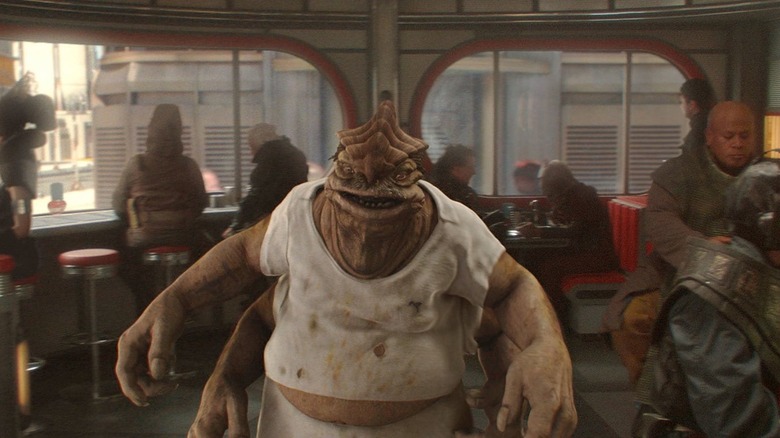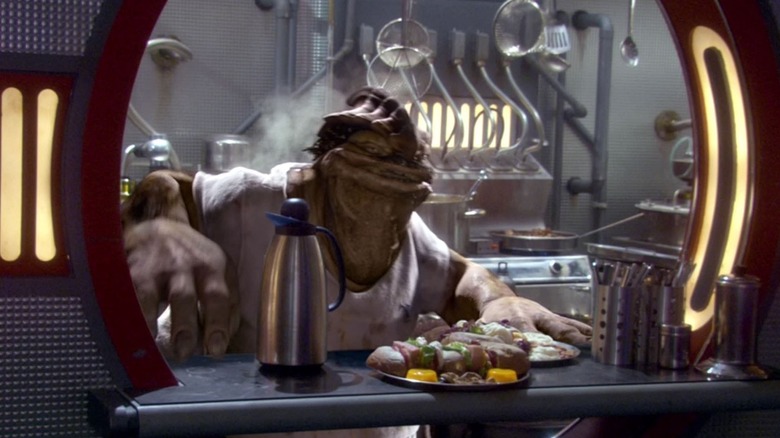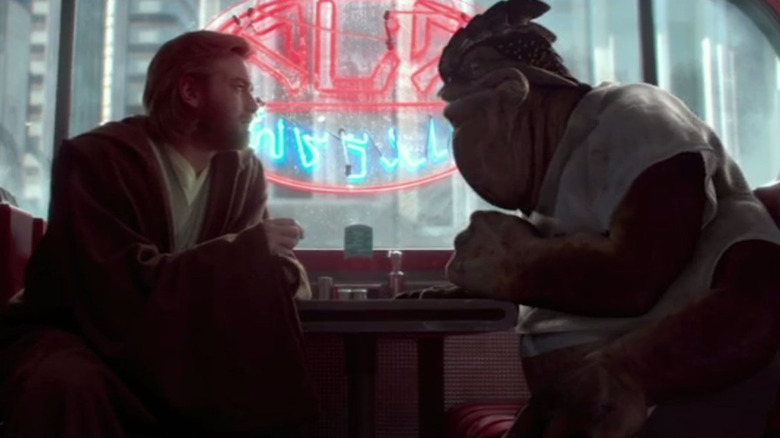George Lucas Based Star Wars' Dexter Jettster On A Legendary Character Actor
Looking over George Lucas' filmography, one can find no films set in the present day. Indeed, only one of Lucas' feature films is set in the future, and his "THX 1138" is a dystopian hellscape of corporate control and utter emotionlessness. His other five directorial efforts are all set in the past, where youth was enjoyable and heroes existed in distant galaxies (even if "American Graffiti" was set just a decade before its release date). The past was bright. It's the future we have to be suspicious of.
Lucas once said that he was influenced by Arthur Lipsett's 1964 short film "21-87," a heady, abstract film about how humanity has reached an inflection point, and that society is now officially primed for collapse. This film, however obscure, offers a handy primer on Lucas' entire body of work. If there is a hero's journey to be had, it belongs in the ancient world. As we move forward in time, entropy sets in. This is a theme that Rian Johnson explored in "Star Wars: The Last Jedi." Everything, it argues, must end.
For a while there in the 2000s, however, Lucas was still having a great time playing with his toys and making "Star Wars" prequel films using state-of-the-art special effects and goofy, fun imagery that appealed to him as a filmmaker. Lucas, born in 1944, was a child during the heyday of 1950s diners, and likely has an affection for them (if "American Graffiti" is any indicator). For his 2002 film "Star Wars: Episode II — Attack of the Clones," Lucas went full-bore self-indulgent and incorporated a legitimate greasy spoon restaurant into the "Star Wars" universe. The diner was run by a thick-bodied bug-like chef named Dexter Jettster (Ronald Falk).
According to "Clones" animator Rob Coleman, in a 2022 interview on the "Star Wars" website, Dexter was modeled specifically on Ernest Borgnine.
Kiss my Gr'iitz
According to expanded "Star Wars" lore, Dexter Jettster belongs to a species called Besalisk, a species that only appeared on "The Clone Wars" TV series, and throughout various "Star Wars" tie-in novels and comic books. He also would have featured heavily into the comedy series "Star Wars: Detours" had the show not been canceled before its release. In the context of "Attack of the Clones," Dexter is an old friend of Obi-Wan Kenobi (Ewan McGregor) and a trusted source of shady information. He only appears in one scene in "Clones," but he was a striking enough figure for the world's Starwoids to remember his name and face.
The production of the "Star Wars" prequel films was massive and elaborate, with every tiny detail overseen by Lucas. The production process was painstakingly described in a series of making-of documentaries available on the "Star Wars" DVDs. Because of the stringent attention to detail, Coleman knew he was going to get a lot of input as to how he was to bring a character like Dexter Jettster to life. Coleman admits bending Lucas' ear a lot, grilling his director as to smaller details of the "Star Wars" universe. He said:
"We had a huge amount of fun bringing him to life. [...] For a lot of the time, for any character, I would ask George — just when we were sitting, waiting for the lights to be changed on set or whatever — about backstory, subtext, and inspirations for characters. I always wanted to know whether there was an actor or a character, you know, that George had seen in an old movie, a favorite of his."
The incomparable Ernest Borgnine
Of course there was an inspiration. Indeed, few elements of "Star Wars" are wholly original, with Lucas borrowing heavily from his favorite movies to construct his ancient sci-fi universe. Yoda, for instance, is a reinterpretation of the title character from Akira Kurosawa's 1975 film "Dersu Uzala." The flying bomb run on the Death Star is a direct reference to the bomb run made by the British pilots in Michael Anderson's 1955 war picture "The Dam Busters." And, of course, the general structure and tone of "Star Wars" comes directly from 1930s "Flash Gordon" serials, right down to the in-medias-res approach to the films' episode numbering; it was rare that one saw 1930s theatrical serials from the beginning.
Dexter Jettster was modeled off Ernest Borgnine, the star of Best Picture winner "Marty," and character actor par excellence. Borgnine's filmography is far too vast to cover briefly, as he appeared in hundreds of movies from the start of his career in 1951 until his death in 2012. His wide, silly grin and propensity for playing upbeat, approachable characters brought a vital presence to American cinema. This author first noticed Borgnine in John Carpenter's sci-fi film "Escape from New York," wherein he played Cabbie.
Knowing Borgnine, Rob Coleman instantly knew what was wanted, saying, "[W]ith Dexter, it turned out it was Ernest Borgnine, who I always loved as a character actor. So immediately, I had all these images in my head."
Dexter's limp, his mannerisms, his tendency to lean in close to Obi-Wan. Fans of Borgnine can see it. The affability of a classic film actor brought a whimsical edge to an otherwise sterile "Star Wars" movie, and for at least one scene, everyone can smile.


